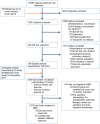Relative Efficacy of Different Exercises for Pain, Function, Performance and Quality of Life in Knee and Hip Osteoarthritis: Systematic Review and Network Meta-Analysis
- PMID: 30830561
- PMCID: PMC6459784
- DOI: 10.1007/s40279-019-01082-0
Relative Efficacy of Different Exercises for Pain, Function, Performance and Quality of Life in Knee and Hip Osteoarthritis: Systematic Review and Network Meta-Analysis
Abstract
Background: Guidelines recommend exercise as a core treatment for osteoarthritis (OA). However, it is unclear which type of exercise is most effective, leading to inconsistency between different recommendations.
Objectives: The aim of this systematic review and network meta-analysis was to investigate the relative efficacy of different exercises (aerobic, mind-body, strengthening, flexibility/skill, or mixed) for improving pain, function, performance and quality of life (QoL) for knee and hip OA at, or nearest to, 8 weeks.
Methods: We searched nine electronic databases up until December 2017 for randomised controlled trials that compared exercise with usual care or with another exercise type. Bayesian network meta-analysis was used to estimate the relative effect size (ES) and corresponding 95% credibility interval (CrI) (PROSPERO registration: CRD42016033865).
Findings: We identified and analysed 103 trials (9134 participants). Aerobic exercise was most beneficial for pain (ES 1.11; 95% CrI 0.69, 1.54) and performance (1.05; 0.63, 1.48). Mind-body exercise, which had pain benefit equivalent to that of aerobic exercise (1.11; 0.63, 1.59), was the best for function (0.81; 0.27, 1.36). Strengthening and flexibility/skill exercises improved multiple outcomes at a moderate level. Mixed exercise was the least effective for all outcomes and had significantly less pain relief than aerobic and mind-body exercises. The trend was significant for pain (p = 0.01), but not for function (p = 0.07), performance (p = 0.06) or QoL (p = 0.65).
Conclusion: The effect of exercise varies according to the type of exercise and target outcome. Aerobic or mind-body exercise may be the best for pain and function improvements. Strengthening and flexibility/skill exercises may be used for multiple outcomes. Mixed exercise is the least effective and the reason for this merits further investigation.
Conflict of interest statement
Nicky Welton declares that she received payment from the Association of British Pharmaceutical Industry to deliver a masterclass on Evidence Synthesis in submission to NICE. Weiya Zhang received honorarium from AstraZeneca and Grunthal for advice on treating chronic hyperuricaemia in people with gout, speaker fees/reimbursements from Bioiberica for EULAR 2016 Satellite Symposium, OARSI for OARSI 2017, Korea College of Rheumatology annual congress 2018, EULAR for EULAR 2018, Heilongjiang Rheumatology Society for the annual meeting in 2018. Siew-Li Goh, Monica S.M. Persson, Joanne Stocks, Yunfei Hou, Jianhao Lin, Michelle C. Hall and Michael Doherty have no conflict of interest to declare.
Figures



References
-
- Nelson AE, Allen KD, Golightly YM, Goode AP, Jordan JM. A systematic review of recommendations and guidelines for the management of osteoarthritis: the chronic osteoarthritis management initiative of the U.S. bone and joint initiative. Semin Arthritis Rheum. 2014;43(6):701–712. - PubMed
-
- Juhl C, Christensen R, Roos EM, Zhang W, Lund H. Impact of exercise type and dose on pain and disability in knee osteoarthritis. Arthritis Rheumatol. 2014;66(3):622–636. - PubMed
Publication types
MeSH terms
Grants and funding
LinkOut - more resources
Full Text Sources
Medical

